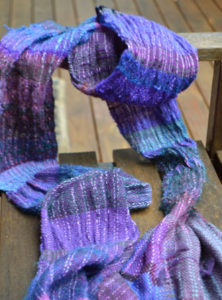 This newest baked scarf features lots of spindled singles yarn wound straight off the spindle to the bobbin. It washed up softly and I used a handdyed tencel and textured cotton warp, with wool, mohair, retro reflective yarn, cotton, lycra and silk in the weft. It is long enough to warp twice around the neck for an autumn weight.
This newest baked scarf features lots of spindled singles yarn wound straight off the spindle to the bobbin. It washed up softly and I used a handdyed tencel and textured cotton warp, with wool, mohair, retro reflective yarn, cotton, lycra and silk in the weft. It is long enough to warp twice around the neck for an autumn weight.
The benefit of weaving straight from handspun singles are great:
1. Colours when spinning can be changed wherever you like using multiple slivers and fibre mixes, to create a dynamic coloured yarn for weaving. Blend any colour mix you like or dye your own sliver/fibre.
2. You have a say in the provenance and origin of the fibre. Aussies can choose Australian wool sliver or NZ wool straight up without all the airfrieght, etc. to other countries to process it for you. (Note to self: try not to publicly moan about our lack of mills) Others can ensure the fibre comes from their own obtainable local sources or sources that they favour.
3. You can wind a bobbin for weaving directly from the spinning wheel spool or the hand spindle. Not only a time saver but better for the spirit to see the immediate translation of the creation of yarn to cloth.
4. From one Bosworth Midi spindle I wound 3 full bobbins which went a very long way on the weave. What a pleasant and unexpected surprise.
5. These yarns create a collapse weave on the textile when washed. This is a very exciting process because it seems almost magical! How did that yarn create such interesting furrows to appear instantly when I waved my wand handwashed it. This is an important personal enlightenment for me. I’ve read and experimented with collapse before but as colour is very important to me in my work the only options were really white collapse yarns which could only be dyed after the cloth was woven allowing no detailed colour surprises or graduations in the weave. This fact always prevented me from going any further with it.
6. I mixed a fine singles with another plyed fibre such as mohair and the collapse effect still worked. These were mixed at the bobbin winding stage.
7. Thrice the enjoyment in the development of the weave. Once for the spinning, twice for the weave, thrice for the wash result.
I could add that number 8 is the smug smile of success.
Note: if you are a beginner reading this I realise I’ve used weave terms to describe a process which might make it sound complicated. But this technique is readily available to a beginner and not intimidating in any way.


Leave a Reply